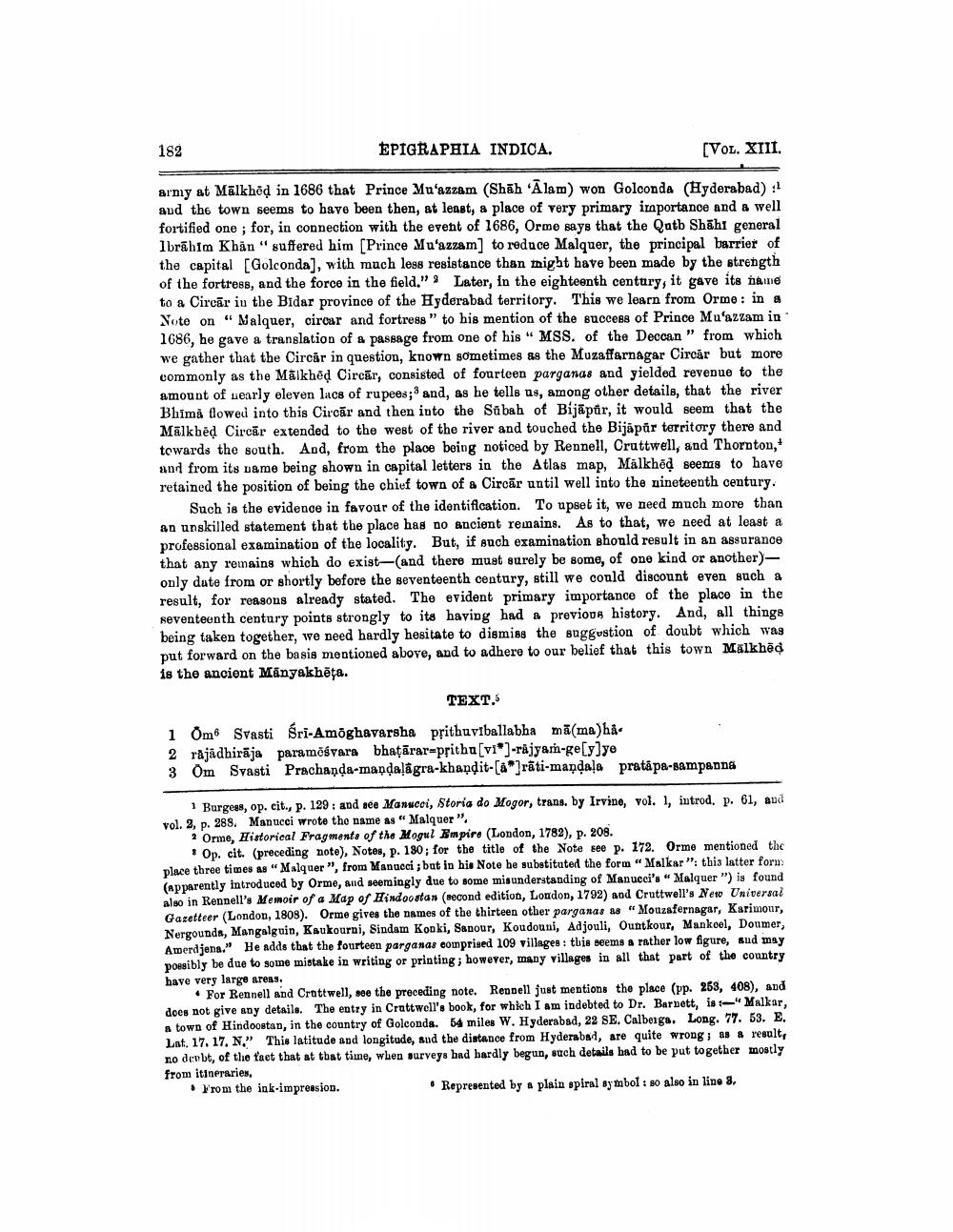________________
182
EPIGRAPHIA INDICA.
(VOL. XIII.
army at Mālkhôd in 1686 that Prince Mu'azzam (Shah Alam) won Golconda (Hyderabad) : and the town seems to have been then, at least, a place of very primary iraportance and a well fortified one ; for, in connection with the event of 1686, Orme says that the Qatb Shahi general Ibrahim Khan suffered him [Prince Mu'azzam] to reduce Malquer, the principal barrier of the capital [Golconda), with much less resistance than might have been made by the strength of the fortress, and the force in the field." | Later, in the eighteenth century, it gave its naine to & Circār in the Bidar province of the Hyderabad territory. This we learn from Orme : in a Yote on “Malquer, circar and fortress" to his mention of the success of Prince Mu'azzam in 1686, he gave a translation of a passage from one of his " MSS. of the Deccan" from which we gather that the Circar in question, known sometimes as the Muzaffarnagar Circar but more commonly as the Mālkhed Circar, consisted of fourteen parganas and yielded revenue to the amount of nearly eleven lacs of rupees; and, as he tells us, among other details, that the river Bhimå flowed into this Circār and then into the Sabah of Bijāpar, it would seem that the Mālkbed Circar extended to the west of the river and touched the Bijapur territory there and towards the south. Aod, from the place being noticed by Rennell, Cruttwell, and Thornton, and from its name being shown in capital letters in the Atlas map, Malkhed seems to have retained the position of being the chief town of a Circār until well into the nineteenth century.
Such is the evidence in favour of the identification. To upset it, we need much more than an unskilled statement that the place has no ancient remains. As to that, we need at least a professional examination of the locality. But, if such examination should result in an assurance that any remains which do exist-(and there must surely be some, of one kind or another) only date from or shortly before the seventeenth century, still we could discount even such a result, for reasons already stated. The evident primary importance of the place in the seventeenth century points strongly to its having had a previous history. And, all things being taken together, we need hardly hesitate to dismiss the buggustion of doubt which was put forward on the basis mentioned above, and to adhere to our belief that this town Malkhēo is the ancient Māngakhēta.
TEXT.
1 Om Svasti śri-Amoghavarsha prithuviballabha mā(ma)hå2 råjädbirāja paramośvara bhatārar-prithu[vio]-rajyam-ge[y]ye 3 Om Svasti Prachanda-mandalāgra-khandit-[a]rāti-mandala pratapa-sampanna
1 Burgess, op. cit., p. 129: and see Manucoi, Storia do Mogor, trans, by Irvino, vol. 1, introd. p. 61, and vol. 2, p. 288. Manucci wrote the name as "Malquer"
? Orme, Historical Fragments of the Mogul Empir. (London, 1782), p. 208.
* Op. cit. (preceding note), Notes, p. 180; for the title of the Note see p. 172. Ormo mentioned the place three times as "Malquer", from Manucci; but in his Note be substituted the form "Malkar": this latter form (apparently introduced by Ormo, and seemingly due to some misunderstanding of Manucci's "Malquer ") is found also in Rennell's Memoir of a Map of Hindoostan (necond edition, London, 1792) and Cruttwell's New Universal Gazetteer (London, 1808). Orme gives the names of the thirteen other parganas a "Mouzafernagar, Karimour, Nergounds, Mangalguin, Kaukourni, Sindam Konki, Sanour, Koudouni, Adjouli, Ountkour, Mankoel, Doumer, Amerdjena. He adds that the fourteen parganas comprised 109 villages : this seems a rather low figure, sud may possibly be due to some mistake in writing or printing; however, many villages in all that part of the country have very large areas.
• For Rennell and Cruttwell, see the preceding note. Rendell just mentions the place (pp. 263, 408), and does not give any details. The entry in Cruttwell's book, for which I am indebted to Dr. Barbett, is-"Malkar, a town of Hindoostan, in the country of Golconda. 54 miles W. Hyderabad, 22 SE, Calbergs. Long. 77. 53. E. Lat. 17. 17, N." This latitude and longitude, and the distance from Hyderabad, are quite wrong; as a result, no doubt, of the fact that at that time, when surveys had hardly begun, such details had to be put together mostly from itineraries, From the ink-impression.
• Represented by plain spiral symbol: so also in line 8.




